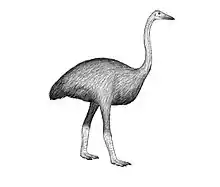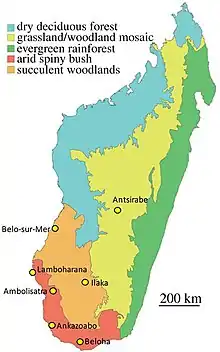Mullerornis
Mullerornis is a genus of extinct elephant birds (Aepyornithidae) of Madagascar.
| Mullerornis | |
|---|---|
 | |
| Restoration | |
| Scientific classification | |
| Kingdom: | Animalia |
| Phylum: | Chordata |
| Class: | Aves |
| Order: | †Aepyornithiformes |
| Family: | †Aepyornithidae |
| Genus: | †Mullerornis Milne-Edwards & Grandidier 1894 |
| Type species | |
| Mullerornis modestus (Milne-Edwards & Grandidier, 1869) Hansford & Turvey 2018 | |
| Species | |
| |
 | |
| Map of Madagascar showing where specimens have been found | |
| Synonyms | |
| |
Description
Mullerornis is smaller than the more well-known Aepyornis.[2][3] A bone possibly belonging to Mullerornis has been radiocarbon dated to about 1260 BP,[4] suggesting that the animal was still extant at the end of the first millennium.[5] Aepyornis modestus was shown by Hansford and Turvey (2018) to be a senior synonym of all nominal Mullerornis species described by Milne-Edwards and Grandidier (1894), resulting in the new combination Mullerornis modestus.[6]
Nocturnality
Like other aepyornithids and its close kiwi relatives, Mullerornis was nocturnal, though it shows less optical lobe reduction than these other taxa, implying slightly more crepuscular habits.[7]
Etymology
The genus is named after Georges Muller, a French explorer, who was killed in 1892 by hostile members of the Sakalava people.
Synonyms of Mullerornis modestus
- Mullerornis betsilei Milne-Edwards & Grandidier, 1894[8] (Betsile elephant-bird)
- Mullerornis agilis Milne-Edwards & Grandidier, 1894 (Agile/coastal elephant-bird)
- Mullerornis rudis Milne-Edwards & Grandidier, 1894[1] (Robust elephant-bird)
- ?Mullerornis grandis Lamberton 1934 (holotype destroyed in a fire in 1995)
Footnotes
- Davies, S. J. J. F. (2003)
- Burney, et al. (1997), p. 763
- MacPhee, et al. (1985), table II
- Burney, et al. (2004), p. 50
- Burney et al. (2004), p. 25
- Hansford, J. P.; Turvey, S. T. (2018-09-26). "Unexpected diversity within the extinct elephant birds (Aves: Aepyornithidae) and a new identity for the world's largest bird". Royal Society Open Science. 5 (9): 181295. doi:10.1098/rsos.181295.
- Christopher R. Torres & Julia A. Clarke. 2018. Nocturnal giants: evolution of the sensory ecology in elephant birds and other palaeognaths inferred from digital brain reconstructions. Proc. R. Soc. B 285 (1890); doi: 10.1098/rspb.2018.1540
- Julian P. Hume; Michael Walters (2012). Extinct birds. T&AD Poyser. p. 544. ISBN 978-1408158616.
References
- Burney, David A.; James, Helen F.; Grady, Frederick V.; Rafamantanantsoa, Jean-Gervais; Ramilisonina; Wright, Henry T.; Cowart, James B. (1997). "Environmental change, extinction and human activity: Evidence from caves in NW Madagascar" (PDF). Journal of Biogeography. 24 (6): 755–767. doi:10.1046/j.1365-2699.1997.00146.x. hdl:2027.42/75139.
- Burney, David A.; Burney, Lida Pigott; Godfrey, Laurie R.; Jungers, William L.; Goodman, Steven M.; Wright, Henry T.; Jull, A. J. Timothy (2004). "A chronology for late prehistoric Madagascar". Journal of Human Evolution. 47 (1–2): 25–63. doi:10.1016/j.jhevol.2004.05.005. PMID 15288523.
- Davies, S. J. J. F. (2003). "Elephant birds". In Hutchins, Michael (ed.). Grzimek's Animal Life Encyclopedia. 8 Birds I Tinamous and Ratites to Hoatzins (2 ed.). Farmington Hills, MI: Gale Group. pp. 103–104. ISBN 0-7876-5784-0.
- MacPhee, R. D. E.; Burney, David A.; Wells, N. A. (1985). "Early Holocene chronology and environment of Ampasambazimba, a Malagasy subfossil lemur site". International Journal of Primatology. 6 (5): 463–489. doi:10.1007/BF02735571. S2CID 44449535.